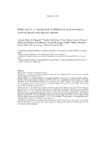Risks factors of mechanical ventilation in acute traumatic cervical spinal cord injured patients

Ver/
Use este enlace para citar
http://hdl.handle.net/2183/19721Coleccións
- Investigación (FCS) [1293]
Metadatos
Mostrar o rexistro completo do ítemTítulo
Risks factors of mechanical ventilation in acute traumatic cervical spinal cord injured patientsAutor(es)
Data
2017-10-23Cita bibliográfica
Montoto-Marqués A, Trillo-Dono N, Ferreiro-Velasco ME, Salvador-de la Barrera S, Rodriguez-Sotillo A, Mourelo-Fariña M, Galeiras-Vázquez R, Meijide-Failde R. Risks factors of mechanical ventilation in acute traumatic cervical spinal cord injured patients. Spinal Cord. 2018 Mar;56(3):206-211.
Resumo
[Abstract] Study design. Descriptive retrospective study.
Objectives. To analyze risk factors associated with mechanical ventilation (MV) in cases of acute traumatic Cervical Spinal Cord Injury (tCSCI).
Setting. Unidad de Lesionados Medulares, Complejo Hospitalario Universitario A Coruña, in Galicia (Spain).
Methods. The study included patients with tCSCI who were hospitalized between January 2010 and December 2014. The following variables were analyzed: age, gender, etiology, neurological level, ASIA (American Spinal Injury Association) grade, associated injuries, injury severity score (ISS), ASIA motor score (AMS) at admission and mortality.
Results. A total of 146 patients met the study’s inclusion criteria. The majority were men (74.7%) with mean age of 62.6 (s.d. ± 18.8) years. Sixty patients (41.1%) required MV. Mean age of ventilated vs. non-ventilated patients was 57.3 vs. 65.7. Men were more likely to require MV than women, ASIA grades A and B were also more likely to need MV than grades C and D, as well as patients with associated injuries. The AMS of patients receiving MV was lower than that of those who did not require MV (20.1 vs. 54.3). Moreover, the ISS was higher in patients receiving MV (31.2 vs. 13.4). An AMS ≤ 37 and an ISS ≥ 13 increased the risk of requiring MV by a factor of 11.98 and 7.28, respectively.
Conclusions. Isolated factors associated with a greater risk of MV in tCSCI were: age, gender, ASIA grade, ISS and AMS. However, the only factor with a significant discriminatory ability to determine the need for MV was the AMS at admission.
Versión do editor
ISSN
1362-4393
1476-5624
1476-5624





